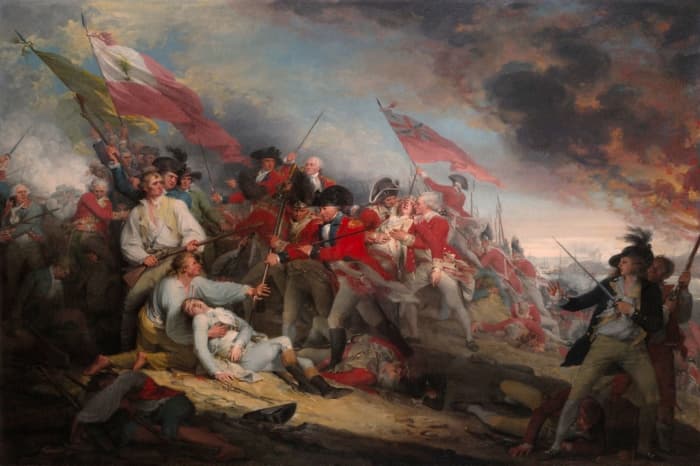
John Trumbull, Battle of Bunker Hill, 1786, detail. Yale University Art Gallery.
Overview
"I don't know what happens. I read the history book. But when I put it down I have no pictures in my head," say the children of immigrants Marsha Ehler teaches and writes about in California. Her students are "strongly visual learners who rely primarily on what they see to help them process information, but they often lack the 'standard collection' of American images (accurate or inaccurate) gleaned" from years of contact with historical stories and images. 1 But how many other school children might also have this "lack of strong iconic images" of historical settings and figures? In this unit, Language Arts and Social Studies interact to enrich middle-school student learning of the Revolutionary War and early American race relations in the context of a recent young-adult historical-fiction novel, Forge, by Laurie Halse Anderson.
But how much visual and information context should be provided for the students? Can the book stand alone? Are actual pictures necessary to help build a library of internal imagery for young readers so they can visualize the setting adequately? This unit identifies what minimal historical background and images related to the setting and characters (escaped slaves during the Revolutionary War) in this novel should be provided to middle-school students before and during the unit to ensure reading comprehension. Images and assignments in the unit direct student thinking to the contradictions in early American history between our founding fathers' ideals - "All men are created equal" - and their tolerance of or active engagement in slave-owning. Students will learn that 5,000 African Americans fought in the American army, but many times that number fought for or joined the British side. The historical contradictions that underlie America's early history are central to this novel and this unit.
This unit applies new Common Core timing recommendations for the best times during reading to introduce historical background, including images, to ensure that students experience the struggle to comprehend the text themselves through close reading. Teachers in states that are now implementing Common Core State Standards will be especially interested in the controversy that labels standard practices of prefacing reading assignments with outside information and interpretation as "frontloading." If not at the front, then when is the right time, if ever, to present additional context to ensure proficient reading comprehension and student connection to unit theme of social justice? All these questions coalesce around the reading of Forge, a well-researched historical first-person novel of a teen boy who escapes slavery to land in the thick of the Revolutionary War. This four-week unit could be used in conjunction with Social Studies units on war and slavery in early America, 2 and it includes activities for "close readings" of historical images, student-produced drawings from the text, nonfiction readings, descriptions of internal visualizations, and a "Picture a Different America" writing assignment.

Comments: